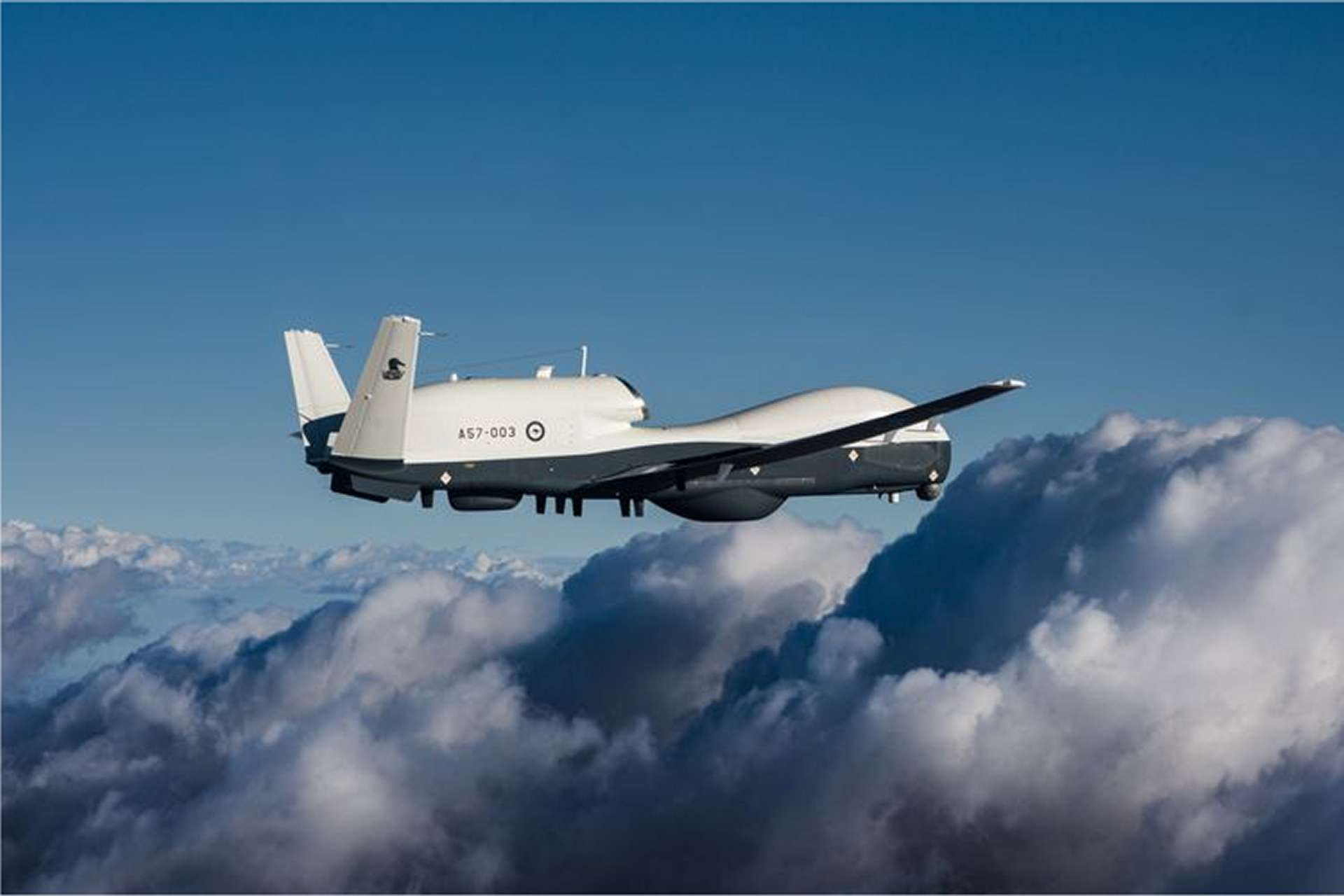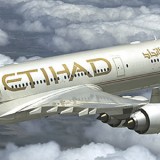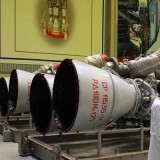Australia Completes Testing of Third MQ-4C Triton UAS for its Air Force

{loadposition bannertop}
{loadposition sidebarpub}
The third MQ-4C Triton Uncrewed Aerial System (UAS) for the Royal Australian Air Force (RAAF), known as “AUS3,” has completed its flight tests. These tests were conducted by Northrop Grumman, the manufacturer of the system, at its Palmdale facility in California. Additional tests are scheduled before the official delivery of the aircraft, which is expected to coincide with the delivery of the second Triton, which is also nearing finalization.
Follow Army Recognition on Google News at this link
The MQ-4C Triton is a reconnaissance and maritime patrol drone developed by Northrop Grumman. (Picture source: Northrop Grumman)
The third Triton is expected to be transferred to Naval Air Station Patuxent River in Maryland, where it will undergo calibration testing alongside the second aircraft. Once fully operational, the aircraft will be assigned to the RAAF’s 9th Squadron, with operations taking place from two bases: RAAF Base Edinburgh in South Australia and RAAF Base Tindal in the Northern Territory. These sites will be essential for conducting surveillance missions in the Indo-Pacific region.
Australia received its first MQ-4C Triton in August 2024 and is set to receive two additional units in 2025. The aircraft, a maritime version of the Global Hawk UAS, is designed to complement the operations of the P-8A Poseidon maritime patrol aircraft. Its primary operational focus will be the northwest coast of Australia, a strategically important area for national defense.
Although the Australian Department of Defence originally expected the MQ-4C Triton to achieve Initial Operational Capability (IOC) by July 2024, delays have pushed the Full Operational Capability (FOC) timeline to mid-2031. This adjustment, mentioned in the Department’s 2020-2021 Major Projects Report, reflects the revised production schedule for the Triton. Despite these delays, the aircraft is considered a critical asset for enhancing Australia’s maritime surveillance capabilities.
The MQ-4C Triton is a reconnaissance and maritime patrol drone developed by Northrop Grumman. This uncrewed system is designed to conduct surveillance missions over large maritime areas, with a particular focus on detecting and analyzing maritime threats. The Triton is an advanced version of the Global Hawk, another high-altitude surveillance drone, but it is specifically adapted for naval operations.
The MQ-4C Triton prototype made its first flight on May 22, 2013, marking the beginning of a series of tests to refine its capabilities. The drone does not require a pilot onboard, but it does require four personnel on the ground to supervise its operations and control its missions. The Triton is powered by a Rolls-Royce F137 engine and has a wingspan of 39.9 meters, a length of 14.5 meters, and a height of 4.6 meters. With an empty weight of 6,781 kg, it is capable of reaching a maximum speed of 575 km/h and can fly for up to 24 hours without interruption, allowing it to cover vast maritime areas.
The total investment for the development and production of the MQ-4C Triton is estimated at $13.24 billion, with a unit cost of $137.9 million for the first units, which increases for versions with research and development. A total of 68 units are planned to be built, in addition to two prototypes, enabling many naval forces worldwide to benefit from its extended surveillance and reconnaissance capabilities.
Australia initially ordered four MQ-4C Tritons but later chose to add two additional units, further enhancing its intelligence, surveillance, and reconnaissance (ISR) capabilities in the region. With its advanced sensors and extended endurance, the Triton is expected to play a key role in securing Australia’s maritime borders and contributing to regional security in the Indo-Pacific.

{loadposition bannertop}
{loadposition sidebarpub}
The third MQ-4C Triton Uncrewed Aerial System (UAS) for the Royal Australian Air Force (RAAF), known as “AUS3,” has completed its flight tests. These tests were conducted by Northrop Grumman, the manufacturer of the system, at its Palmdale facility in California. Additional tests are scheduled before the official delivery of the aircraft, which is expected to coincide with the delivery of the second Triton, which is also nearing finalization.
The MQ-4C Triton is a reconnaissance and maritime patrol drone developed by Northrop Grumman. (Picture source: Northrop Grumman)
The third Triton is expected to be transferred to Naval Air Station Patuxent River in Maryland, where it will undergo calibration testing alongside the second aircraft. Once fully operational, the aircraft will be assigned to the RAAF’s 9th Squadron, with operations taking place from two bases: RAAF Base Edinburgh in South Australia and RAAF Base Tindal in the Northern Territory. These sites will be essential for conducting surveillance missions in the Indo-Pacific region.
Australia received its first MQ-4C Triton in August 2024 and is set to receive two additional units in 2025. The aircraft, a maritime version of the Global Hawk UAS, is designed to complement the operations of the P-8A Poseidon maritime patrol aircraft. Its primary operational focus will be the northwest coast of Australia, a strategically important area for national defense.
Although the Australian Department of Defence originally expected the MQ-4C Triton to achieve Initial Operational Capability (IOC) by July 2024, delays have pushed the Full Operational Capability (FOC) timeline to mid-2031. This adjustment, mentioned in the Department’s 2020-2021 Major Projects Report, reflects the revised production schedule for the Triton. Despite these delays, the aircraft is considered a critical asset for enhancing Australia’s maritime surveillance capabilities.
The MQ-4C Triton is a reconnaissance and maritime patrol drone developed by Northrop Grumman. This uncrewed system is designed to conduct surveillance missions over large maritime areas, with a particular focus on detecting and analyzing maritime threats. The Triton is an advanced version of the Global Hawk, another high-altitude surveillance drone, but it is specifically adapted for naval operations.
The MQ-4C Triton prototype made its first flight on May 22, 2013, marking the beginning of a series of tests to refine its capabilities. The drone does not require a pilot onboard, but it does require four personnel on the ground to supervise its operations and control its missions. The Triton is powered by a Rolls-Royce F137 engine and has a wingspan of 39.9 meters, a length of 14.5 meters, and a height of 4.6 meters. With an empty weight of 6,781 kg, it is capable of reaching a maximum speed of 575 km/h and can fly for up to 24 hours without interruption, allowing it to cover vast maritime areas.
The total investment for the development and production of the MQ-4C Triton is estimated at $13.24 billion, with a unit cost of $137.9 million for the first units, which increases for versions with research and development. A total of 68 units are planned to be built, in addition to two prototypes, enabling many naval forces worldwide to benefit from its extended surveillance and reconnaissance capabilities.
Australia initially ordered four MQ-4C Tritons but later chose to add two additional units, further enhancing its intelligence, surveillance, and reconnaissance (ISR) capabilities in the region. With its advanced sensors and extended endurance, the Triton is expected to play a key role in securing Australia’s maritime borders and contributing to regional security in the Indo-Pacific.




